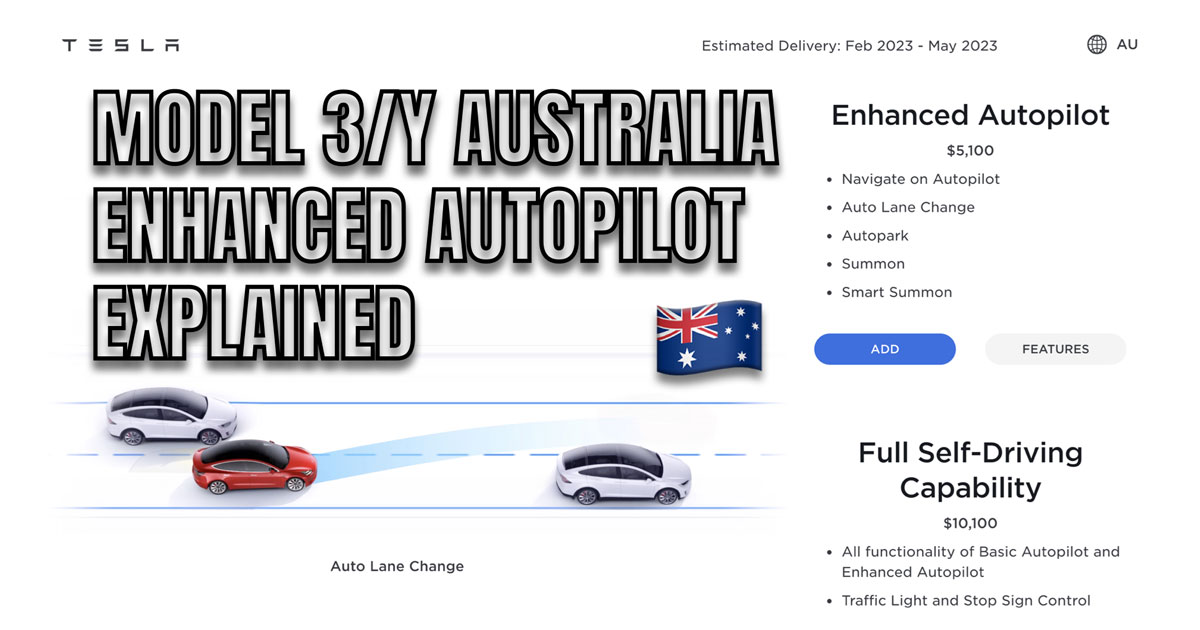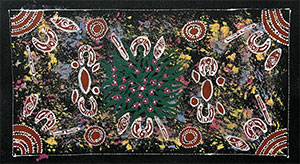
Enhanced Autopilot vs Full Self Driving in Australia
I’d like to highlight the differences between Basic Autopilot, Enhanced Autopilot and Full Self-Driving Capability for Tesla Model 3 and Model Y
Before we get into the differences, I’d like to make it clear that this information is specific to my situation living in an urban area in Sydney, Australia in June 2022. These features may be different in your part of the world depending on laws and regulations in different markets.
So let’s begin with Basic Autopilot. This feature is included with all new Tesla Model 3 and Y in Australia. As per the Tesla website, Basic Autopilot enables your car to steer, accelerate and brake automatically for other vehicles and pedestrians within its lane. Advanced safety and convenience features are designed to assist you with the most burdensome parts of driving, alongside driver assistance features such as emergency braking, collision warning and blind-spot monitoring.
Regular viewers of my YouTube channel will know that I frequently document the use of Basic Autopilot particularly when it comes to software update videos. Autopilot is essentially traffic aware cruise control with auto steering and lane-centering*. The car will set to your desired speed, sometimes with restrictions depending on where you are. It may also adjust to the current speed limit using a combination of both the car’s cameras to read posted speed signs and built-in GPS map data that is regularly updated. It’s traffic aware, meaning it will follow the leading car as closely as the limit set by the driver. Autosteer and lane-centering means it will follow lane markings. In reality, these features work reasonably well on urban roads and very well on highways and freeways. On our recent 4000km road trip, I would have used Basic Autopilot the majority of the time while on regional highways.
The main drawback of Basic Autopilot is phantom braking. This occurs when the car is overly sensitive with obstacles and will brake on its own using the built in forward collision warning system. As you can imagine, this can be potentially dangerous if you are being tailed by a large vehicle behind you.
The other drawback is that if the road does not have good lane markings or if there are poor weather conditions such as heavy rain, snow or harsh glare from the sun, then autopilot will switch off automatically. For these reasons, Tesla autopilot still remains at SAE Level 2 driverless autonomy meaning you need to supervise it at all times and be ready to take over at any time. You can not and should be distracted under any circumstances when using autopilot.
Overall, Basic Autopilot works very well and is a fantastic driver aid, particularly on the open road and for this reason I would give Basic Autopilot a score of 8.5/10 in its current state. 85%
Now let’s explore Tesla’s Enhanced Autopilot option which at $5100 in Australia represents very good value. Enhanced Autopilot includes everything already mentioned in Basic Autopilot with the addition of Navigate on Autopilot, Auto Lane Change, Autopark, Summon and Smart Summon. Let’s go through each feature.
Auto Lane Change - While driving on the highway, Automatic Lane Change will position your car in the optimal lane to prepare for merges and exits while overtaking slow cars. Drivers are given clear insight to upcoming lane changes as well as customisation to Auto Lane Change functionality. This feature alone is worth the additional $5100 for Enhanced Autopilot. It’s extremely useful on highways when you’re on a road trip, particularly if you need to pass slower vehicles while already on autopilot. Without Auto Lane Change and if already on autopilot, then you’d have to turn off Basic Autopilot, manually overtake and then re-engage Basic Autopilot. This is not a huge inconvenience but after a few hours into a long drive, this may be something you’d wish you had!
The one drawback of using Auto Lane Change to overtake a big truck is that if the car is only travelling a few km/h higher than the truck’s speed, you may experience phantom braking issues. The car will need to be travelling at least 10-15 km/h faster to avoid this. In reality, Auto Lane Change works really well on the open road and is my favourite feature of this enhanced autopilot suite. For that, I’m giving it 9/10.
Navigate on Autopilot is automatic driving. On paper, that sounds fantastic BUT it does not work as well as you may think particularly here in Australia especially when it comes to taking on and off ramps from freeways. At some exits it wants to merge the other way i.e. left instead of right and vice versa which is extremely dangerous at high speed. I think this may be a mismatch in programming given NoA was developed mostly for left hand drive markets. Also be aware that some of our big regional roads are not true freeways and have occasional cross roads. When a car approaches a cross road, it will switch back to Basic Autopilot.
Auto Lane Change works with Navigate on Autopilot and there are settings for how aggressively you want the car to change lanes. The tolerance can be customised from mild to Mad Max Mode, you can imagine what that’s like. Other customisation options include allowing the car to lane change by itself with or without confirmation depending on your nerve. I don’t use Navigate on Autopilot much anymore and I don’t think we used it at all during our 4000km journey and for this reason I’m giving it 5/10. It’s just not reliable enough and it freaks the wife and kids out. Sorry Tesla.
The next feature is Autopark and since a software update in October 2021 (2021.36) the car uses ‘Camera Only’ to perform this manoeuvre. From personal testing, it works with perpendicular parking but not with parallel parking. It’s slower than how I would park with my level of experience and skill and I don’t feel comfortable using it in a busy carpark with a line of cars waiting for me. For this reason I’m scoring it 6/10.
Summon is potentially handy if you have a very tight parking space. This uses your Tesla app as a remote control to drive the car in straight lines. This works reasonably well, I’m scoring it 7/10.
Smart Summon is similar to Summon above but in two dimensions ie. not restricted to a straight line. Again, you use your Tesla app again to retrieve your car. There are limitations to how far away your car can be. It has potential use if it’s raining heavily and you have a lot of shopping? Again, it’s one of those features that sounds great in theory but in practice I wouldn’t recommend it in a busy parking lot. I have never personally tried it outside of testing it for the channel or showing it as a party trick. I think Tesla has this feature to show what can be achieved one day with an autonomous taxi fleet. For me, I’m scoring it 6/10.
Full Self-Driving (FSD) capability is Basic Autopilot and Enhanced Autopilot with the addition of traffic light and stop sign control.
By the way, viewers have told me that Tesla have confirmed with them that Enhanced Autopilot can be upgrade to Full Self-Driving one day for an extra $5000 i.e.the balance in pricing if you want to upgrade.
Tesla vehicles, even with Basic Autopilot, will show traffic lights and other visualisations on screen while driving but you will need FSD capability for the car to react to traffic lights and stop signs. If you are the first car at a traffic light and if it turns red, the car will stop. For a green light, if you are following a line of cars, it will automatically go on green. However if you are the first car going through a green light then you’ll have to confirm either with your accelerator pedal or by tapping down your right stalk.
The biggest benefit of FSD capability is the potential to test Autosteer on city streets i.e. what is commonly known as FSD Beta in USA and Canada. There are plenty of videos online showcasing FSD beta with Elon Musk tweeting recently that there is a possibility of FSD beta dropping in right hand drive markets ‘later this year’. Of course if you don’t wish to experience this higher level of autonomous driving, then FSD is not worth the extra $5k just to have the extra traffic light and stop sign controls which to be really frank, can be a bit annoying having to confirm green lights all the time. So for FSD capability, I am giving it 5/10 as the features for an Australian market in 2022 are not worth the additional cost. I would have scored it even lower if not for the fact that Elon Musk has previously said that once FSD beta hits your market, then prices will rise. So if you want to lock in today’s FSD price to safeguard against a future rise, then it may be worth that extra $5000.
"Lane-centering" is a specific term used on the Australian Tesla website and the spelling here is deliberate.
Basic Autopilot 85%
Enhanced Autopilot 66%
Based on an aggregate score is 33/50 but keeping in mind I gave Auto Lane Change 9/10 with that alone being worth the $5100 for Enhanced Autopilot.
Full Self-Driving 50%
At today’s standard
So you can see Basic Autopilot included with the car alone is excellent value. And Enhanced Autopilot with the Auto Lane Change presents excellent value particularly if you plan to take any road trips.
The last time Enhanced Autopilot was offered in Australia, prior to now, it was only very short lived but I have a feeling it will be here to stay given Elon showed in a recent tweet that he would expand it to other markets worldwide.
If you recently managed to order a Tesla Model Y or 3 in Australia before the recent price rise then congratulations! If you are considering adding EAP or FSD to your purchase, I would strongly suggest calling or emailing your Tesla rep instead of doing it yourself online because you’ll note that when you review your new addition, it will take into account the new higher MSRP pricing and of course you wouldn’t want to do that. Also, adding EAP or FSD pre-delivery puts you at risk of going over the Luxury Car Tax Threshold in Australia. You can avoid some if not all of the LCT if you add EAP or FSD after taking delivery via your Tesla app. Also bear in mind that adding EAP or FSD may tip you over the stamp duty threshold exemption in some states for the RWD Model Y so please be aware of that before you add it to your order.
